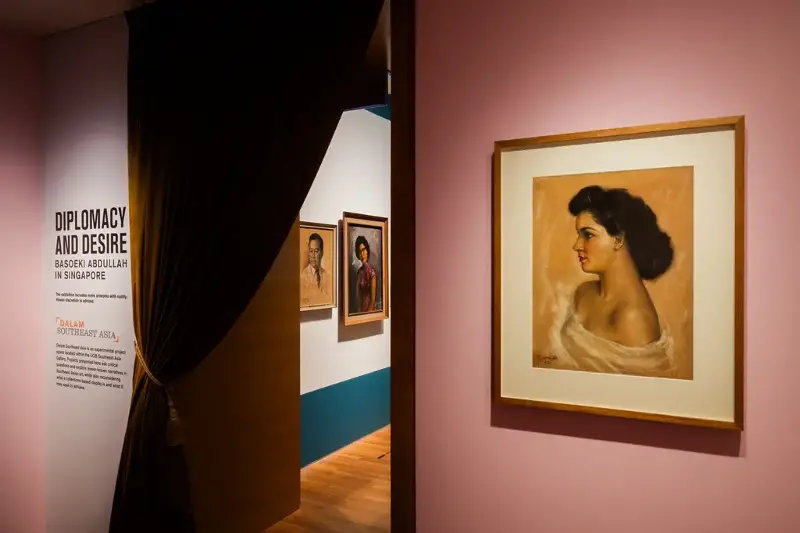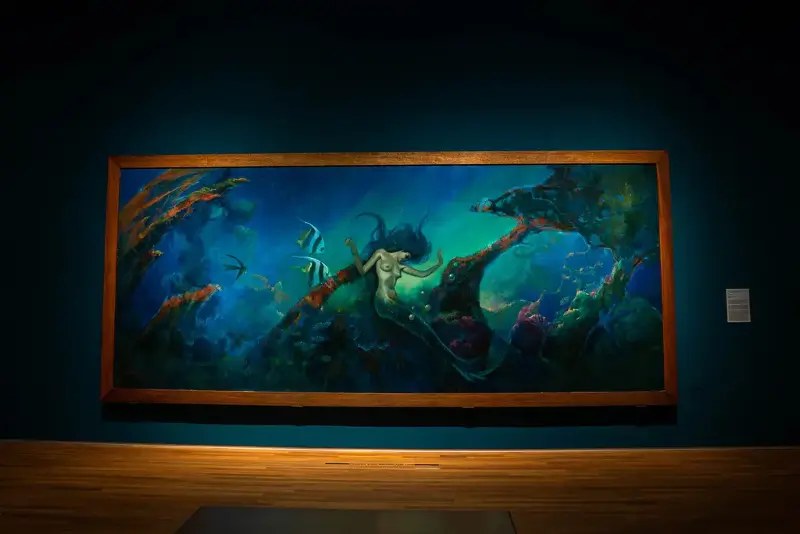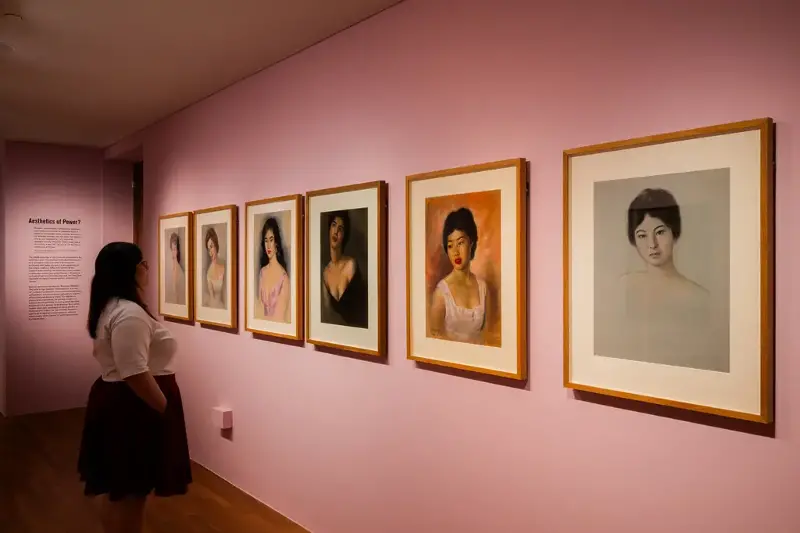Yep, I’m back again with another National Gallery experience–much sooner than you probably expected after the last article, huh? This time, unlike the previous exhibit that whisked us off both to the heart of Spain and the islands of the Philippines, we’re staying local with a concise but equally compelling exhibit titled Diplomacy and Desire: Basoeki Abdullah in Singapore.
Being the newest addition to Dalam Southeast Asia—the gallery’s experimental project that showcases curatorial experimentation and lesser-known perspectives on the region’s art and histories—this exhibition is a glimpse at power, beauty, and diplomacy in the region through the eyes of one of Southeast Asia’s most sought-after portraitists.
So, with exhibit curator Dr. Kathleen Ditzig guiding me through the experience, let’s waste no time diving into this exhibit—and maybe even into the mind—of Basoeki Abdullah.
Diplomacy and Desire: Basoeki Abdullah in Singapore

Let’s start with the basics: Who is Baseoki Abdullah? Born in 1915 in Solo, Java, to the family of well-known Mooi Indie painter Raden Abdullah Suriosubroto, Basoeki followed in his father’s footsteps and eventually earned the title of “the Rembrandt of the East.”
After having achieved international fame by winning an art competition held for the coronation of Queen Juliana of Amsterdam in 1948, Basoeki spent much of his later life travelling around the globe to paint stalwart statesmen and attractive women–a pretty sweet gig, if you ask me.
But don’t get it twisted, because beyond the glitz and glamour, Basoeki was also deeply driven by a personal desire to evoke the realities of postcolonial movements through his self-described style of “Romantic Realism,” the same passion that Diplomacy and Desire sets out to explore.
So, before we take a look at a few of Basoeki’s pieces to start understanding how he seamlessly navigated both his roles as a high-society painter and a cultural producer attuned to the “geopoetic” value of his works, do be warned: some of his artworks—like the one we’ll cover in full 4K glory—do contain a bit of artistic nudity, so discretion is advised.
But with that said, if you’re ready to see some beauties (and I’m not just talking about the women!), let’s jump right in.
On Diplomacy

The first gift Basoeki Abdullah gave to Singapore that we’ll take a look at is Labour–an imposing painting which spans almost three metres long. Gifted to the City Council of Singapore in 1959 during the year it achieved self-governance, this monumental work has also been featured in Tropical: Stories from Southeast Asia and Latin America–a self-explanatory exhibit at the National Gallery and one we’ve also covered! Anyways, when Basoeki returned to the Lion City in 1989 to seek out the painting, he claimed that it actually represented the future of Singapore!
Now, don’t get mad–after all, he genuinely meant well. As exhibition curator Dr. Kathleen Ditzig points out during our curatorial tour of the exhibit, while the scene may bear a striking resemblance to John Martin’s The Fall of Babylon, there’s no real sign of destruction here. Take a closer look–do you spot the labouring men, their heavy supplies, and the crane positioned off to the right? That’s right, this isn’t a scene of ruin, it’s instead one of construction, one of labour.
What’s more, the structures in the painting also reference key historic sites, such as the temples for Ramesses II and Queen Nerfertari at Abu Simbel, Egypt. These two massive buildings indeed had to be relocated piece by piece in 1964 as part of President Nasser’s ambitious Aswan Dam Project, and surprisingly, the move was successful.
That’s why said relocation project—along with monuments that seem to resemble Borobudur (the world’s largest Buddhist temple), Hagia Sophia (a church-turned-mosque located in present-day Turkey), and a shikhara (a tower typical of North Indian Hindu temple architecture)—may suggest that Basoeki was inspired by the possibilities for allied progress between “coloured nations” shared at the seminal Bandung Conference of 1955, a meeting of 29 Asian and African states.
Therefore, when he said that the painting represented the future of Singapore, that was actually a compliment–one that correctly predicted the nation’s emergence as a multicultural society!

Next, the second and final painting Basoeki Abdullah gifted to Singapore is Struggle for the Re-establishment of the Democracy and the Right of the People–a similarly sized painting with a definitely longer name. While it’s puzzling to learn that the artwork’s title was provided by politicians, what was even harder to take in was the fact that this painting also doesn’t have an official interpretation.
Okay, technically it does have one, but even Dr. Ditzig says that’s up for debate. Apparently, the reading claims that the mermaid is Nyai Roro Kidul, the Queen of the Southern Sea in Javanese and Sudanese folklore, whom Basoeki has depicted in other paintings.
However, even putting aside the tale’s unsupported authenticity, the reason why this reading is still so controversial is that the supernatural being is not always represented as a mermaid. Plus, based on what the gallery knows about him, there’s no chance he gifted this painting without some sort of political intent as well.
So, here’s a more reasonable interpretation: the painting is supposedly inspired by the formation of the Association of Southeast Asian Nations (ASEAN) in 1967, with the mermaid symbolising the association, and more intriguingly, the five pearls beside her representing its founding members.
Specifically, according to Basoeki, the latter metaphor stems from the idea that, similarly to how pearls are gems produced out of a painful process; the successes of Indonesia, Malaysia, the Philippines, Singapore, and Thailand all emerged as a result of the difficult paths each endured during the era of decolonisation.
Though mermaids and pearls aside, I absolutely adore the depth of colours used in the piece’s background. No matter which story you choose to believe, I hope that you can also at least agree that the vibrant red corals and golden, refracted sunlight look absolutely majestic.
And Desire

But do you know what else is absolutely–sorry, I’ll stop myself there. Anyway, as the final highlight of this exhibit and the overall article, here’s just one wall of a corridor showcasing a selection of Basoeki’s pastel drawings of striking models.
Drawn in Singapore in 1958, despite the untitled portrait second from the right being officially listed as Chinese Woman with Red Lips, did you know that she also bears a resemblance to beauty queen Daisy Szeto?
As an award-winning bikini model who participated in fashion and film events in the 1950s, in 1959, Szeto was crowned “The Pearl of the Orient” at the Singapore Constitution Exposition’s beauty pageant, where—surprise, surprise—Basoeki was one of the judges on the panel who selected her as a winner.
Additionally, the woman on the right of Ms. Szeto’s doppelgänger? She also seems to resemble someone familiar. During the celebrations for the same 1959 Singapore Constitution Exposition, two Japanese beauticians, Yoshiko Miyamoto and Nagayo Ishihara, visited Singapore on behalf of Shiseido (yes, that Shiseido).
The women then posed for Basoeki as part of a promotional campaign for the cosmetic brand’s beauty products, and—drumroll, please—the beautician that most closely resembled the portrait is none other than…Nagayo Ishihara!
On a more poignant note, when I asked Dr. Ditzig why the gallery had decided to open Diplomacy and Desire during this time, she surprised me by flipping the question back.

In an era where the rules-based order of our world are being tested even in our backyard, whether through the US’ recent tariffs or the long-standing inaction from ASEAN on the Myanmar civil war, what lessons could visitors like me take away from Basoeki Abudullah’s desire for countries to weather the storm and build a new future together?
Should we view his depictions of the future with cynical nihilism, believing the dream of a united Southeast Asia has been indefinitely deferred? Or should we see them as aspirations to strive for–a vision of a better tomorrow within reach, so long as we keep believing?
And though I didn’t get the chance to share my answer with her, I also knew that a real answer lies in what one chooses to do next. Therefore, come down to Diplomacy and Desire: Basoeki Abdullah in Singapore–and discover your own answers, face-to-face with these highlights and more.
🗓Date: 9 May 2025 to 1 February 2026
📍Location: Supreme Court Wing, Level 3, UOB Southeast Asia Gallery, Dalam Southeast Asia, National Gallery, Singapore 178957
💲Price: Free for Singaporeans and PRs
⏰Time: 10am to 7pm
Also, while you’re at it, check out the rest of Dalam Southeast Asia to experience Southeast Asian modern and contemporary art from brand-new perspectives. And as always, don’t forget to follow and tag the National Gallery on Instagram and TikTok when sharing your experience for a chance at being reposted on their socials. See you at the next National Gallery exhibit!
Photos by Zheng Yi of the DANAMIC team. Additional visuals courtesy of National Gallery Singapore.
